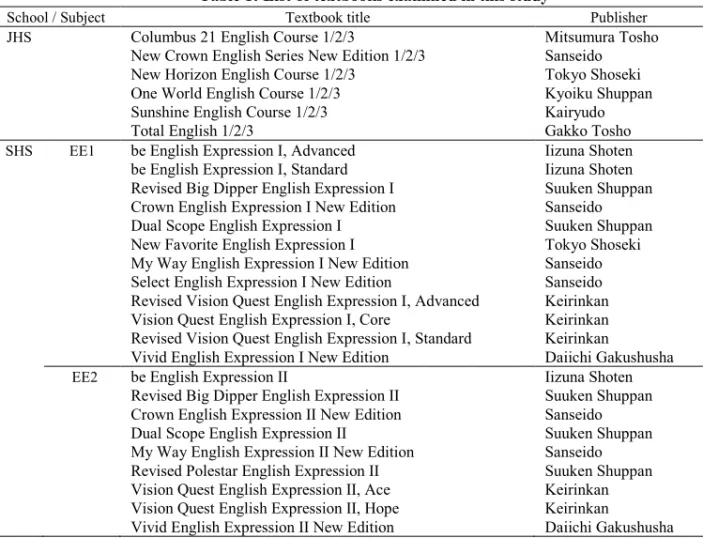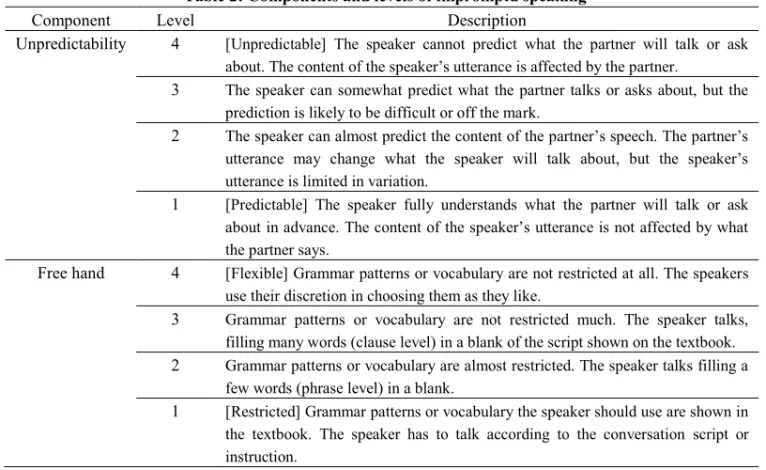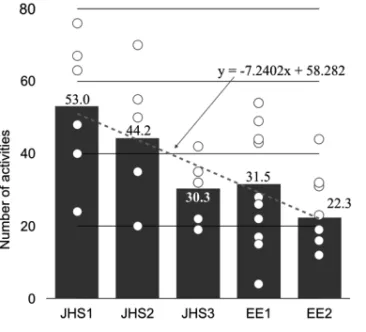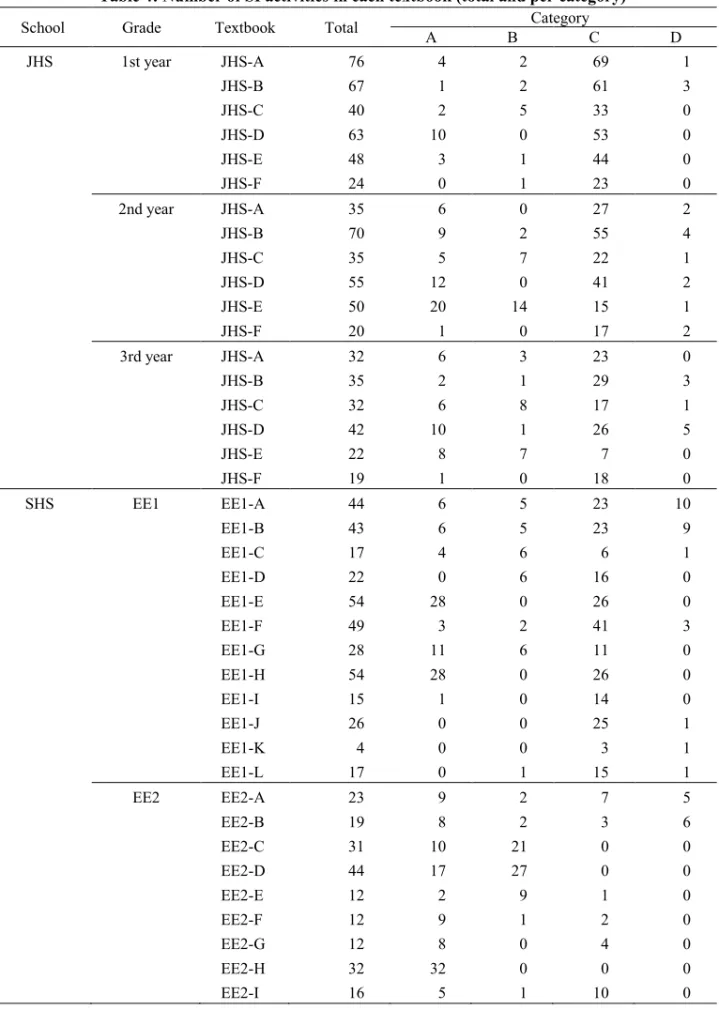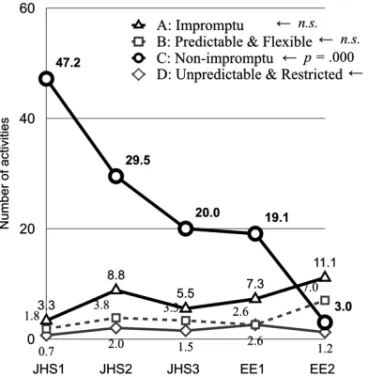国際地域研究論集(JISRD)第10号(№ 10)2019 論文
Do authorized secondary school English textbook activities promote genuine impromptu interactions?
CHINO Junichiro
1and URABE Shozo
2The role of impromptu speaking activities has gained increased attention from teachers and researchers in the field of English language teaching in Japan. This study examines the degree to which textbooks for secondary schools (JHS and SHS) in Japan facilitate impromptu spoken interaction (SI).
SI activities in 39 textbooks were analyzed using a hypothetical model. The results indicated that (1) higher-grade textbooks offered fewer SI activities, and (2) the number of non-impromptu SI activities decreased, whereas the number of impromptu activities did not show a significant increase. The study concludes that these textbooks do not provide sufficient opportunity to students to speak without preparation. Accordingly, teachers must focus on modifying the activities in the textbook they use or on developing their own impromptu SI activities.
Key words: spoken interaction, impromptu speaking, speaking activity, textbook analysis
1 Introduction
1-1 㻌 Speaking opportunities and anxiety
Considering that Japan is an EFL country, students have few opportunities to speak the target language outside the classroom (Yashima et al, 2004; Yokota, 2014). Tsuchiya (2016) indicated that spoken production activities in class, which require students to write, edit, and practice oral presentations, demand considerable time and effort. Thus, teachers are reluctant to set such activities. Furthermore, he suggested that this relative lack of speaking activities is one of the causes of the increase in the number of students who have difficulty speaking English. Moreover, fewer speaking opportunities result in a lack of confidence in speaking among students (Akkakoson, 2016; Horwitz, Horwitz, & Cope, 1986; Mahmud, 2018; Thornbury, 2005).
This lack of impromptu speaking practice in senior high school (SHS) increases speaking anxiety among university students. Chino (2018) conducted a qualitative investigation of the factors and structures affecting university students’ feelings toward impromptu speaking. Notably, the students surveyed had been studying English diligently, and their overall English proficiency was relatively high. The study indicated that if students’
English classes in SHS focused more on written skills and grammatical accuracy, they felt a certain level of anxiety about impromptu speaking and was comfortable speaking English only after a great deal of preparation.
In addition, the results revealed that if students lacked the opportunities for impromptu speaking in SHS and developed a sense of inferiority, they preferred to avoid participating in impromptu speaking and would give up talking about a given topic when they encountered communication breakdown, though they expressed their intention to study hard to improve their speaking proficiency.
論文
1-2 㻌 Impromptu spoken interaction
The current course of study (gakushu shido yoryo) for English Expression, one of the English language subjects in SHS, specifies that teachers must ensure that students speak without preparation on a given topic (MEXT, 2015). The forthcoming course of study requires even junior high school (JHS) students to be able to use simple words and sentences to talk about an interesting topic in an impromptu way (MEXT, 2018). The word “impromptu” occurs as many as 23 times in the practical guide accompanying the new course of study.
Evidently, English language education in Japan is placing increasing emphasis on impromptu speaking.
However, many students are not given sufficient impromptu speaking practice in school. MEXT (2016a;
2016b) sent a questionnaire to both JHS and SHS students throughout the country. It inquired whether they had sufficient speaking activities in which they were required to speak without preparation. The results indicated that 45% of third-year JHS students and 64.3% of third-year SHS students felt that they had not been given enough opportunities for impromptu speaking.
3MEXT concluded that teachers should start with simple activities, such as informal discussion with classmates, and engage students more in spoken interaction (SI) activities.
1-3 㻌 Textbooks and impromptu speaking
Teachers need to incorporate more speaking activities in English class to offer more impromptu speaking practice to students. In principle, teachers are expected to use speaking activities included in the authorized textbook they have adopted. The use of government-approved textbooks is easier and more convenient as well as a legal requirement in Japan.
However, impromptu speaking activities are often fundamentally incompatible with the content in textbooks.
The impromptu nature of students’ SI might be lost if a textbook sets out the content of a speaking activity in detail, such as the conversation structure, the words or expressions students should use, or instructions about what to ask and answer in pairs. For first-year JHS students, who are novice learners of English and have difficulty speaking fluently, teachers often prefer to use a textbook that offers detailed instructions to manage their class more smoothly. Thus, if we describe a speaking activity more precisely in a textbook, the conversation will be less impromptu and will turn out to be a more “drill-like” pattern practice.
㻌It is similar to the situation in which a train will run straight and smoothly if we set it on the right track but will neither derail nor determine which route to take on its own will.
Although numerous studies have focused on the analysis of English textbooks, few studies have explored the impromptu aspect of speaking activities. This study discusses the degree of improvisation of SI activities in English textbooks authorized for JHSs and SHSs.
2 Methods
2-1 㻌 Research questions
This study mainly examines the proportion of impromptu speaking activities in ministry-approved English
textbooks for Japanese secondary schools. The research questions are as follows:
1. How many SI activities are included in JHS and SHS English textbooks?
2. Are there any differences between textbooks for different grades in terms of distribution of SI activities and their approach to improvisation?
2-2 㻌 Materials
All six current JHS textbooks published for the academic year 2018 were examined. Among SHSs in which several English subjects are taught, the textbooks for English Expression I and II were chosen. Textbooks for Communication English I, II, and III were excluded from the study despite the fact that this subject is allotted more time than English Expression. This is because the current course of study for Communication English does not place any emphasis on impromptu speaking; instead the textbooks prioritize reading comprehension activities. Of the English Expression I and II textbooks published for the academic year 2018, the top 12 and nine textbooks were selected in descending order of market share (See Table 1 for the full list of textbooks examined in this study).
In general, speaking activities are classified into two types of speech: production and interaction. Though students also talk without preparation in spoken production activities, this study focuses on SI activities since
㻌interaction activities usually involve a greater degree of impromptu speaking. Likewise, though impromptu
Table 1: List of textbooks examined in this study
School / Subject Textbook title Publisher
JHS Columbus 21 English Course 1/2/3 Mitsumura Tosho
New Crown English Series New Edition 1/2/3 Sanseido
New Horizon English Course 1/2/3 Tokyo Shoseki
One World English Course 1/2/3 Kyoiku Shuppan
Sunshine English Course 1/2/3 Kairyudo
Total English 1/2/3 Gakko Tosho
SHS EE1 be English Expression I, Advanced Iizuna Shoten
be English Expression I, Standard Iizuna Shoten
Revised Big Dipper English Expression I Suuken Shuppan Crown English Expression I New Edition Sanseido
Dual Scope English Expression I Suuken Shuppan
New Favorite English Expression I Tokyo Shoseki
My Way English Expression I New Edition Sanseido Select English Expression I New Edition Sanseido Revised Vision Quest English Expression I, Advanced Keirinkan Vision Quest English Expression I, Core Keirinkan Revised Vision Quest English Expression I, Standard Keirinkan
Vivid English Expression I New Edition Daiichi Gakushusha
EE2 be English Expression II Iizuna Shoten
Revised Big Dipper English Expression II Suuken Shuppan Crown English Expression II New Edition Sanseido
Dual Scope English Expression II Suuken Shuppan
My Way English Expression II New Edition Sanseido Revised Polestar English Expression II Suuken Shuppan Vision Quest English Expression II, Ace Keirinkan Vision Quest English Expression II, Hope Keirinkan
Vivid English Expression II New Edition Daiichi Gakushusha Note. EE1 = English Expression I. EE2 = English Expression II.
The textbooks are listed alphabetically, and their order does not correspond to the code names mentioned below,
such as JHS-A and EE1-B.
“writing” is also an important language activity, it was excluded from the scope of this investigation.
All the SI activities were extracted from textbooks and workbooks or activity books contained in the teachers’ manual. A total of 1,600 activities were examined according to the classification method mentioned in the next section.
2-3 㻌 Component elements of impromptu speaking
In this study, “impromptu” refers to expressing one’s opinions or communicating with others without preparing beforehand. “Improvisation” is the noun form of “impromptu” and refers to “being impromptu.”
Previous studies have explored factors impacting speaking act (e.g., Ellis, 2003; Robinson, 2001; Skehan, 1998;
Tomita, Oguri, & Kawauchi, 2011). This study hypothesizes that improvisation comprises two components. The first component is “unpredictability of topics or contents to be treated in an immediate utterance” (hereafter,
“unpredictability”). When we have enough time to think about what we will say before uttering or know what we will be asked about before the conversation, it is possible to rehearse in our head, which makes the utterance less impromptu. In contrast, when we cannot predict what to talk about or what the conversation will be, we have to start speaking without preparation; this can be called an impromptu utterance.
The other component is “free hand in choosing grammar or sentence patterns to be produced” (hereafter,
“free hand”). This means that we can speak freely without being restricted by grammar or sentence patterns indicated in a textbook or by a teacher. Students are directed to speak using a certain sentence format in many speaking activities in Japan. For example, in a pair activity on a JHS textbook, they are supposed to use the sentences shown on the page and have a conversation such as “A: Hi, [partner’s name], what [food/color] do you like? –B: I like ___.” In this conversation, Student B has to only fill a few words in the blank, and they can
Table 2: Components and levels of impromptu speaking
Component Level Description
Unpredictability 4 [Unpredictable] The speaker cannot predict what the partner will talk or ask about. The content of the speaker’s utterance is affected by the partner.
3 The speaker can somewhat predict what the partner talks or asks about, but the prediction is likely to be difficult or off the mark.
2 The speaker can almost predict the content of the partner’s speech. The partner’s utterance may change what the speaker will talk about, but the speaker’s utterance is limited in variation.
1 [Predictable] The speaker fully understands what the partner will talk or ask about in advance. The content of the speaker’s utterance is not affected by what the partner says.
Free hand 4 [Flexible] Grammar patterns or vocabulary are not restricted at all. The speakers use their discretion in choosing them as they like.
3 Grammar patterns or vocabulary are not restricted much. The speaker talks, filling many words (clause level) in a blank of the script shown on the textbook.
2 Grammar patterns or vocabulary are almost restricted. The speaker talks filling a few words (phrase level) in a blank.
1 [Restricted] Grammar patterns or vocabulary the speaker should use are shown in
the textbook. The speaker has to talk according to the conversation script or
instruction.
comprehend that they will talk about a known topic before starting the conversation.
In this study, a hypothetical model was devised. The two components of improvisation (as outlined above) were categorized into four levels, as shown in Table 2.
Next, two researchers determined the levels of each speaking activity according to the criteria of those two components. When each researcher reached a different conclusion, the levels were decided upon consultation between the two. This can be illustrated using three activities as an example. In Activity (a) in Table 3, the speakers cannot predict what the partners will talk about, or they have to adjust the utterance to respond to the partner’s speech properly (unpredictability level 4). In this activity, no mention is made about grammar items or vocabulary to be used (free hand level 4). Therefore, the activity was described as “Level 4 & 4.”
The unpredictability component of Activity (b) can be described as Level 1 since the partner’s (Student A’s) question is already set out in the textbook and the speaker (Student B) knows what they will be asked beforehand. The speaker is then required to fill in the blank with a few words to answer the question (free hand level 2). Activity (b) can therefore be classified as “Level 1 & 2.”
In Activity (c), the questions are shown in the textbook and the speaker does not need to listen to what the partner asks (unpredictability level 1), but the speakers exercise their discretion in choosing a sentence pattern and appropriate vocabulary when answering the questions (free hand level 4). The activity can therefore be described as “Level 1 & 4.”
Table 3: Examples of determination of the level of a SI activity
Activity Description of textbook U F
(a) Direction: Talk about one of your favorite books with your partner. [EE2-H,
#1569
4] 4 4
(b) A: What is your dream?
B: My dream is (ex. to be a famous entertainer). [EE1-L, #712] 1 2 (c) Direction: Talk about the questions in pairs.
A: What is your hobby? — B:
A: Why do you like it? — B: [EE2-C, #1429]
1 4
Note. U = Unpredictability. F: Free hand
Figure 1 illustrates the distribution of the three example activities (a)–(c). The horizontal axis of the chart represents the level of unpredictability, and the vertical axis represents the free-hand level. It is therefore possible to divide SI activities into 16 types based on two components of four levels. As Figure 2 demonstrates,
Figure 1: The example of activity distribution
Figure 2: Degree of improvisation
Figure 3: Four categories of speaking activity
c a
b
an activity plotted in the upper right quadrant of the chart is regarded as more impromptu, whereas an activity in the lower left quadrant is considered to be less impromptu.
To simplify the interpretation of these findings, these 16 types were grouped into four illustrative categories, as shown in Figure 3: Category A in the upper right quadrant of the chart was named “impromptu,” with the descriptors of the other categories in counterclockwise order being “predictable & flexible,” “non-impromptu,”
and “unpredictable & restricted.” Of these four categories, categories A (impromptu) and C (non-impromptu) will be focused on and compared in the discussion below.
3 Results
3-1 㻌 The number of SI activities in textbooks for each grade
5Table 4 presents the total number of SI activities in each textbook and shows the number of activities included in categories A to D. Based on these results, textbooks for different grades can be compared. The number of SI activities in each textbook varied, as shown in Figure 4. For example, first-year JHS textbooks (JHS1) contained between 24 and 76 SI activities. English teachers often develop their own communication activities tailored to the needs or abilities of their students. However, the teachers need to determine whether the textbook they use contains a sufficient number of SI activities. If there are few activities, they need to develop their own supplementary materials.
The average number of SI activities in JHS1 textbooks was 53.0, the highest of all five grades. Higher-grade textbooks contained noticeably fewer activities, with only 22.3 in EE2. According to the regression line, higher-grade textbooks include approximately 7.2 fewer activities. Statistical analysis using the non-parametric Kruskal–Wallis test revealed significant differences among the grades (χ² = 12.4, p = .02).
6Figure 4: Average number of SI activities and variation
Note. The circles indicate the number of activities in each textbook. The dotted line represents the
regression line.
Table 4: Number of SI activities in each textbook (total and per category)
School Grade Textbook Total Category
A B C D
JHS 1st year JHS-A 76 4 2 69 1
JHS-B 67 1 2 61 3
JHS-C 40 2 5 33 0
JHS-D 63 10 0 53 0
JHS-E 48 3 1 44 0
JHS-F 24 0 1 23 0
2nd year JHS-A 35 6 0 27 2
JHS-B 70 9 2 55 4
JHS-C 35 5 7 22 1
JHS-D 55 12 0 41 2
JHS-E 50 20 14 15 1
JHS-F 20 1 0 17 2
3rd year JHS-A 32 6 3 23 0
JHS-B 35 2 1 29 3
JHS-C 32 6 8 17 1
JHS-D 42 10 1 26 5
JHS-E 22 8 7 7 0
JHS-F 19 1 0 18 0
SHS EE1 EE1-A 44 6 5 23 10
EE1-B 43 6 5 23 9
EE1-C 17 4 6 6 1
EE1-D 22 0 6 16 0
EE1-E 54 28 0 26 0
EE1-F 49 3 2 41 3
EE1-G 28 11 6 11 0
EE1-H 54 28 0 26 0
EE1-I 15 1 0 14 0
EE1-J 26 0 0 25 1
EE1-K 4 0 0 3 1
EE1-L 17 0 1 15 1
EE2 EE2-A 23 9 2 7 5
EE2-B 19 8 2 3 6
EE2-C 31 10 21 0 0
EE2-D 44 17 27 0 0
EE2-E 12 2 9 1 0
EE2-F 12 9 1 2 0
EE2-G 12 8 0 4 0
EE2-H 32 32 0 0 0
EE2-I 16 5 1 10 0
The results indicated that first-year JHS students engage in 5.3 SI activities per month, assuming 10 months in the academic year. Furthermore, EE2 includes only 22.3 SI activities. EE2 is usually taught for two years, for second-year and third-year SHS students. It can therefore be assumed that in EE2, students participate in SI activities only once or twice a month on average despite the fact that English Expression focuses on speaking as well as writing.
3-2 㻌 Differences in SI activity categories between grades
Figure 5 presents the number of SI activities in categories A to D. The Kruskal–Wallis test revealed significant differences only for Category C (χ² = 24.8, p = .000). Within this category, a multiple comparison procedure was applied to textbooks across all grades, revealing significant differences between JHS1 and EE2 (p = .000) and JHS1 and EE1 (p = .01).
Category C comprises non-impromptu speaking activities such as mechanical conversation drills. In this activity, for instance, students create dialogues by choosing a suitable picture from three options or using a set of sentences provided in the textbook. This type of activity enables students to communicate with their classmates without thinking about what to say or how to compose their responses. Accordingly, the students are
“pretending” to maintain a conversation. Since JHS1 students are novice learners of English, approximately half of the SI activities included in JHS1 textbooks are focused on non-impromptu, “drill-like” communication.
Furthermore, there are only 3.3 impromptu activities in JHS1 textbooks. This means that students are offered only a limited number of opportunities to speak without preparation throughout the year unless teachers devise their own impromptu activities or modify other activities in the textbooks.
The total number of SI activities gradually declines across the grades, as shown in Figure 4; concomitantly, higher-grade textbooks offer fewer non-impromptu activities. Notably, non-impromptu activities remain predominant until EE1. Figure 6 presents the percentage of each category in textbooks for each grade. It shows
Figure 5: Average number of SI activities in each category
Figure 6: Percentage of each category
in textbooks for each grade
that over 60% of SI activities in JHS2 through EE1 focus on non-impromptu conversation (Category C).
The percentage of impromptu activities (Category A) rises in JHS2 but remains at approximately 20% until EE1. According to Figure 5, textbooks for this grade offer between 5 and 8 impromptu activities throughout the year. Clearly, textbooks do not offer enough regular opportunities to students for impromptu speaking.
This tendency changes in EE2. Figures 5 and 6 depict a sharp drop in Category C activities in EE2, while Category A activities suddenly increase from 23% to 49.8%. In EE2, emphasis is no longer placed on simple activities such as conversation drills or short question and answer practice but on discussion and debate activities. These activities require students to choose appropriate words and sentence patterns, compose sentences, and respond quickly and spontaneously to their interlocutors. However, even at this level, textbooks offer no more than 11.1 impromptu activities throughout the academic year.
4 Discussion
Based on these results, the following findings should be noted. First, textbooks for the higher grades offer fewer SI activities. It seems reasonable to assume that relatively more time would be devoted to spoken rather than written English at lower levels of study; JHS1 textbooks would therefore include more SI activities compared with textbooks for any other grade. Furthermore, there are fewer SI activities as students advance to the next grade. This may be because greater focus needs to be placed at this level on spoken production and reading/writing activities than on SI activities. In this respect, English teachers must comprehend how the textbook they have adopted is organized and how many activities for each skill are covered. They must decide whether the number of activities they need to have in class can be covered using only the textbook. Overall, there are only 22.3 SI activities in EE2, as shown in Figure 4. Teachers of English Expression should note that the textbooks offer students little chance to practice SI: only once a month, assuming that the book is used for two years.
Second, figures 5 and 6 depict that the number of non-impromptu activities is lower in higher-grade textbooks. Furthermore, the number of impromptu activities does not increase significantly. With the exception of EE2, most SI activities in textbooks do not involve impromptu conversation. In most SI activities, students are able to predict their partner’s utterance before beginning their conversation and are not given the freedom to choose grammar or sentence patterns.
Third, English teachers should also focus on the transition from EE1 to EE2. In EE1, the number of SI activities and the percentage of each category are similar to that in textbooks for JHS3. In contrast, EE2 contains fewer SI activities and most of the activities are impromptu, requiring students to construct sentences and responses unaided. If they have lacked opportunities to practice impromptu speaking before EE2, a sudden emphasis on impromptu speaking might create a sense of anxiety.
Overall, there are a limited number of SI activities in the textbooks examined. There are few interaction activities in which students are required to speak spontaneously, as long as teachers use the textbooks as it is.
To solve this problem, additional effort is needed on the part of teachers to expose students to more impromptu
speaking activities. The first and most common solution is for teachers to develop their own supplementary
activities and teach without solely relying on the textbook. For example, Ejiri (2018) reported that in his
elementary school class, he conducted a “dice talk” game, in which students roll a die and have to converse in
English each time they roll a one.
Alternatively, teachers must modify the activities in a textbook. For example, the following speaking conversation for first-year JHS students is classified as Level 1 & 2, Category C.
A: Do you have any plans for this weekend?
B: Yes. I’m going to _________________. [JHS2-B #482]
In this activity, Student B can anticipate what they will be asked without listening to their partners since both students can look at the conversation script in the textbook and only one question is provided. Even if a teacher finds it difficult to encourage beginner-level students to talk freely for an extended time, it is possible to adjust the level of impromptu speaking as follows:
A: Do you have any plans for [ tonight / tomorrow / this Friday / this weekend / next week / ]?
B: Yes. I’m going to _________________.
In this revised activity, the degree of unpredictability is increased since Student B now needs to listen to their partners and appropriately respond to the partner’s question. The activity can therefore be described as Level 2
& 2. This is still considered to be a non-impromptu activity (Category C). Student B is still able to prepare for all possible questions, but it is possible to adjust the activity for a higher level by making it more impromptu.
5 Conclusion
This study has examined the impromptu aspects of speaking activities in government-authorized English textbooks in Japan. The numerical results of the textbook analysis indicate that higher-grade textbooks offer fewer SI activities. Furthermore, it indicates that the number of non-impromptu activities decreases in higher-grade textbooks, while the number of impromptu activities does not increase significantly. It can therefore be concluded that the textbooks do not provide a sufficient number of impromptu activities and that teachers need to devote more time to modify or supplement textbook activities.
This study has two limitations. First, each activity was treated equally, regardless of whether it was a simple activity such as a drill conversation in pairs or a longer activity requiring a whole class such as a debate or a discussion as part of a research project. The importance placed on the difficulty of each activity was therefore unclear. Second, the data from Communication English was not collected although the subject is essential in SHSs.
Finally, this study focused only on an analysis of textbooks. Therefore, further research on ways in which English teachers approach impromptu speaking activities and promote spontaneous conversation among their students would be of value for improving both students’ speaking skills and the quality of classroom teaching more broadly.
References
Akkakoson, S. (2016). Speaking anxiety in English conversation classrooms among Thai students. Malaysian
Journal of Learning and Instruction, 13, 63-82.
Chino, J. (2018). Sokkyo-teki speaking-ni taisuru ishiki-to gakushu keiken — eigo chukyu level-no daigakusei-no baai [Learning experiences and attitudes toward impromptu speaking: The case of intermediate-level university students]. Journal of the Chubu English Language Education Society, 47, 17-24.
Ejiri, H. (2018). Yaritori dekiru chikara-wo sodateru shogakko gaikokugo-no jissen. [Practice of foreign language teaching in elementary school seeking to foster interactive skill.] Eigo Kyoiku, 66(11), 13-14, Tokyo: Taishukan Shoten.
Ellis, R. (2003). Task-based language and teaching. Oxford: Oxford University Press.
Horwitz, E. K., Horwitz, M. B., & Cope, J. (1986). Foreign language classroom anxiety. The Modern Language Journal, 70(2), 125-132.
㻌Mahmud, Y. S. (2018). Tracing back the issue of speaking anxiety among EFL Indonesian secondary students:
From possible causes to practical implications. Journal of English Language Studies, 3(2), 125-138.
MEXT (Ministry of Education, Culture, Sports, Science and Technology). (2015). Koto-gakko gakushu shidou yoryo kaisetsu: Gaikokugo hen & Eigo hen [Senior high school practical guide for the new Course of Study: Foreign languages and English]. Tokyo: Kairyudo.
MEXT (2016a). Heisei 27 nendo eigo kyoiku kaizen-no tame-no eigoryoku chousa jigyou (chugakko) houkokusho [ Report on the English ability research project for improvement of English education, Heisei 27 (junior high school)]. http://www.mext.go.jp/a_menu/kokusai/gaikokugo/1377767.htm MEXT (2016b). Heisei 27 nendo eigo kyoiku kaizen-no tame-no eigoryoku chousa jigyou (koutougakko)
houkokusho [ Report on the English ability research project for improvement of English education, Heisei 27 (senior high school)]. http://www.mext.go.jp/a_menu/kokusai/gaikokugo/1377767.htm MEXT (2018). Chugakkou gakushu shidou yoryo kaisetsu: Gaikokugo hen [Junior high school practical guide
for the new Course of Study: Foreign languages]. Tokyo: Kairyudo.
Robinson, P. (2001). Task complexity, task difficulty, and task production –Exploring interactions in a componential framework. Applied Linguistics, 22, 27-57.
Skehan, P. (1998). A cognitive approach to language learning. Oxford: Oxford University Press.
Thornbury, S. (2005). How to teach speaking. Harlow: Pearson.
Tomita, K., Oguri, Y, & Kawauchi, C. (Eds.) (2011). Listening-to speaking-no riron to jissen [Listening and speaking: Theory and practice for effective teaching]. Tokyo: Taishukan Shoten.
Tsuchiya, T. (2016) Hanasukoto-ga nigate-na ko-e-no follow [How to support students who do not like speaking], Eigo Kyoiku, 65(10), 16-17, Tokyo: Taishukan Shoten.
Yashima, T., Zenuk-Nishide, L., & Shimizu, K. (2004). The Influence of attitudes and affect on willingness to communicate and second language communication. Language Learning 54(1), 119-152.
Yokota, H. (2014). SLA-no shiten-kara kangaeru shite-ii ‘hikizan’, saketai ‘hikizan’ [Good subtraction and bad subtraction from a standpoint of SLA], Eigo Kyoiku, 62(12), 26-27, Tokyo: Taishukan Shoten.
Notes
1
Faculty of International Studies and Regional Development, University of Niigata Prefecture (chino@unii.ac.jp)
2
Department of General Education, National Institute of Technology, Nagaoka College
3
The total number of students who answered “I don’t think so” or “I'd rather not think so.” The participants of the
questionnaire were asked to answer using a four-point Likert scale.
4
The number after the mark # indicates the activity code in the database made in this research.
5
In this paper, English Expression I and II were regarded as the textbooks for SHS1 and SHS2 for descriptive purposes, respectively. English Expression I is used for the second-year students in some schools, and English Expression II is used for the third-year students as well as the second-year students in many schools.
6
